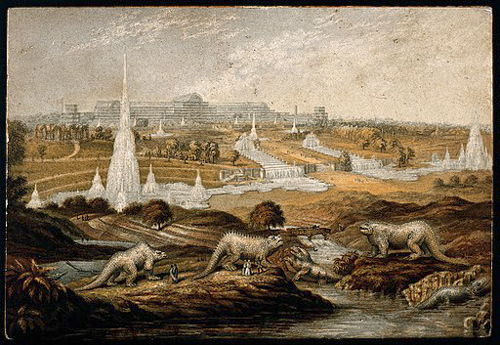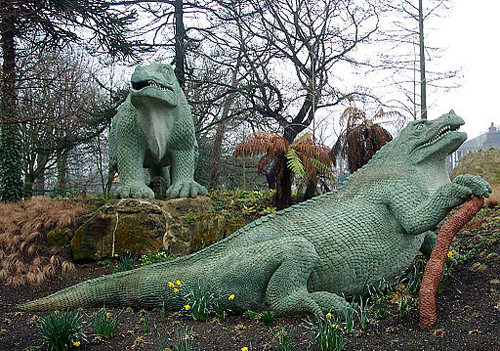
The world’s first life-size dinosaur models, including two gigantic
Iguanodon, are in urgent need of conservation. The models were built over 160 years ago for the one of the World’s very first prehistoric theme parks, located at Sydenham, south London. The aim of the park was to reconstruct what was then known about the history of life on Earth. The park spreads out below the site of Crystal Palace, which burned down in 1936. That remarkable glass structure was originally built for the Great Exhibition of 1851 and subsequently relocated to Sydenham. The Palace, its extensive park and array of over 30 models of dinosaurs and other prehistoric beasts was opened by Queen Victoria in 1854.
Now, after prolonged exposure to the elements there is an urgent need for the conservation of this historic outdoor exhibit of ancient life. The Friends of the Crystal Palace Dinosaurs have launched an appeal—for details see
https://cpdinosaurs.org/
The iconic
Iguanodon is of particular relevance for the Sedgwick Museum, as we are one of the few museums in the world to have a complete replica skeleton of this impressive beast. Around 120 million years ago
Iguanodon roamed the landscapes of western Eurasia, today known as southern England, Belgium, France and Germany.
First giant plant-eater
Not only is
Iguanodon one of the first dinosaurs to be found, it is also one of the most famous, even though it was not a ferocious, predatory flesh-eater, but a more docile plant-eater. The Sedgwick Museum’s historic
Iguanodon specimen is one of our greatest treasures. The impressive skeleton, which reaches right up to the Museum ceiling, towers over visitors, so much so that some young children find it a bit overwhelming.
Reconstructing Iguanodon
The first
Iguanodon remains were found in the South of England and although fragmentary, they were used to make one of the earliest reconstructions of a dinosaur. In 1834, the English physician, Gideon Mantell pictured
Iguanodon first as some kind of gigantic lizard. He used the recently discovered plant-eating
Iguana from South America, with its distinctive teeth as a model. By scaling up from
Iguana’s bones and teeth, Mantell estimated that had
Iguanodon grown to some 59 ft (18m) in length. At the time,
Iguanodon was by far the largest known land animal.
After London’s Great Exhibition of 1851, the sculptor Benjamin Waterhouse Hawkins was commissioned by the Crystal Palace Company to reconstruct some 30 life-size models of a variety of extinct animals from across prehistory. Sited in the vast grounds surrounding the relocated Crystal Palace, the models illustrate the history of life. The scheme developed from a suggestion made by Prince Albert.
One the most impressive models was a life-size
Iguanodon, which had undergone yet another transformation at the hands of the famous English anatomist Richard Owen. Owen modelled the great beast as a strange, scaly-skinned creature with huge elephant-like legs to support its massive body. And, the rhinoceros-like horn, as depicted earlier by Mantell, was still on its nose. Although, shortly afterwards Owen realized that it was in fact a claw bone.
Belgian find transforms Iguanodon yet again
In 1878, one of the greatest fossil dinosaur discoveries ever made was that of over 35
Iguanodon skeletons 322 m below ground in a Belgian coalmine. Realising their scientific importance, the miner’s skills were diverted to recovering the skeletons, which were painstakingly reconstructed by the French-born palaeontologist Louis Dollo.
The complete skeletons showed that Owen’s reconstruction was wrong.
Iguanodon’s hind legs were much longer and more powerful than the arms. Even so, the arms had huge hands whose thumbs were capped by large horny spikes—the spike mistakenly seen as a rhinoceros-like horn in earlier models.
What animal model to use?

The scientists still had a problem in deciding
Iguanodon’s appearance as there are no living reptiles which have the same anatomy. Dollo chose a combination of the long-legged ostrich-like bird—the cassowary and the wallaby, a kangaroo-like mammal, which uses its long muscular tail to rest upon as a kind of third leg. As a result, Dollo mounted his
Iguanodon skeletons standing semi-erect on their hind legs. The long powerful tail is shown trailed on the ground, while its long neck rises nearly vertically. The effect was to portray a vaguely giraffe-like animal that was capable of browsing on high-growing foliage. The only iguana-like aspect left was its numerous leaf-shaped teeth, which are well-adapted for chewing plant material.
Iguanodon comes to Cambridge
Recognising the international importance of the find, the Belgian palaeontologists, with support from King Leopold II, cast the best-preserved skeleton. Replica casts were offered to the university museums of both Oxford and Cambridge, where they are still hold pride of place in the displays.
Iguanodon redux yet again
In making his reconstruction, Dollo passed over some critical evidence preserved in his skeletons. One of these can easily be spotted in the Sedgwick Museum’s cast. If you look carefully at the backbones of the tail, you will see that the blade-like projection from the top of each backbone has a series of interconnecting rod-like structures. Called ossified tendons, these help stiffen the muscular tail and restrict its movement.
In Dollo’s upright reconstruction the tail has to be bent, like that of a wallaby. But if you look at the ossified tendons in this region of the tail, you will see that the bend displaces the interconnections. To restore the true position of the tail, it has to be straightened. Much of our modern understanding of
Iguanodon comes from research carried out by Dr David Norman of the Department of Earth Sciences in Cambridge.
Iguanodon today
To live and move with such a stiff straight tail,
Iguanodon would have had to bend down forwards, so that its hands come close to the ground. The fingers of each hand had hooves for better traction when walking. In this position a much better balance is achieved. The powerful hind limbs and massive pelvis lift the heavy body from the ground. At the front, the head, long neck, arms and chest are balanced over the pelvis by huge muscular and stiff tail. Consequently, this was not an animal capable of running at breakneck speed, but with its long muscular legs it could walk very quickly, perhaps around 20 km per hour (12 mph).
The Sedgwick Museum’s
Iguanodon display outlines its history of discovery and how its posture has had to change over what is nearly 200 years since the first fossil remains were found in the 1820s.
Visit the Sedgwick Museum to see if you can spot the ‘ossified tendons’ that Dollo overlooked in his reconstruction.
Douglas Palmer
Sedgwick Museum
Images:
Top: The "Crystal Palace" from the Great Exhibition, installed at Sydenham: sculptures of prehistoric creatures in the foreground. Coloured photomechanical print, later than 1854?. after: George Baxter and Joseph Paxton and Isambard Kingdom Brunel and Benjamin Waterhouse Hawkins Published. (Credit: Wellcome Library, London. Wellcome Images
[email protected] http://wellcomeimages.org. Copyrighted work available under Creative Commons Attribution only licence CC BY 4.0
http://creativecommons.org/licenses/by/4.0/)
Bottom: Victorian Dinosaurs in Crystal Palace (Credit:
http://www.cgpgrey.com. CC BY 2.0:
https://creativecommons.org/licenses/by/2.0)